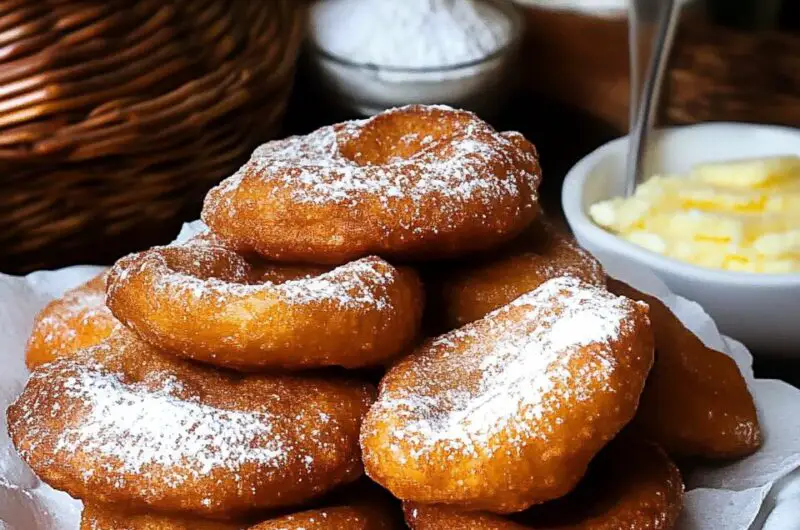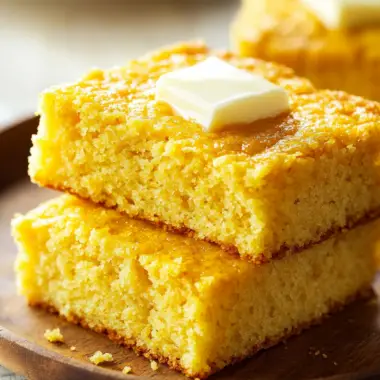Haitian Beignets are a beloved Caribbean pastry that offer a taste of the islands in every bite. These fluffy, deep-fried delights are flavored with warm spices like nutmeg and cinnamon, creating a comforting aroma that fills the kitchen while they cook. The slightly crisp exterior contrasts beautifully with the pillowy interior, and a dusting of powdered sugar adds a sweet, elegant finish. Perfect for breakfast, a mid-day snack, or a festive dessert, these Haitian Beignets are both nostalgic and satisfying. They reflect the rich culinary heritage of Haiti, blending French techniques with Caribbean warmth and flavor. Whether you’re hosting a family brunch or simply craving a homemade treat, this recipe is a crowd-pleaser that will bring joy to your table.
Full Recipe:
Ingredients:
-
2 cups all-purpose flour
-
1/2 cup sugar
-
1 tablespoon baking powder
-
1/2 teaspoon salt
-
1/2 teaspoon nutmeg
-
1/2 teaspoon cinnamon
-
2 large eggs
-
3/4 cup evaporated milk
-
1 teaspoon vanilla extract
-
1 tablespoon butter, melted
-
Vegetable oil, for frying
-
Powdered sugar, for dusting
Directions:
-
In a large mixing bowl, whisk together the flour, sugar, baking powder, salt, nutmeg, and cinnamon.
-
In a separate bowl, beat the eggs, then mix in evaporated milk, vanilla extract, and melted butter.
-
Slowly add the wet ingredients into the dry mixture, stirring to combine until a thick batter forms.
-
Heat oil in a deep fryer or large pot to 350°F (175°C).
-
Use a spoon or small ice cream scoop to drop spoonfuls of batter into the hot oil.
-
Fry the beignets in batches until golden brown, about 3-4 minutes per side.
-
Remove with a slotted spoon and drain on paper towels.
-
Once slightly cooled, generously dust the beignets with powdered sugar. Serve warm.
Prep Time: 10 minutes | Cooking Time: 20 minutes | Total Time: 30 minutes
Kcal: 215 kcal | Servings: 6 servings
Haitian Beignets: A Taste of Caribbean Comfort
Haitian Beignets are more than just a delicious fried pastry; they are a symbol of tradition, culture, and communal joy. Often served during special occasions or simply enjoyed as an afternoon snack, these fluffy treats are a beloved part of Haitian culinary heritage. While the concept of beignets may bring to mind the powdered sugar-covered doughnuts of New Orleans, Haitian Beignets have their own unique identity shaped by local ingredients, flavors, and cooking techniques that reflect the rich and vibrant Haitian culture.
Made with a simple batter infused with warm spices like nutmeg and cinnamon, then deep-fried to golden perfection and dusted with powdered sugar, Haitian Beignets embody the essence of comfort food. They are often enjoyed with a cup of tea or coffee and bring a nostalgic warmth that transcends generations. Whether you’re exploring Caribbean cuisine for the first time or looking to recreate a childhood memory, this recipe is both approachable and deeply rewarding.
Cultural Significance and Heritage
Food plays a critical role in Haitian society, not only as nourishment but as a way of preserving history and heritage. Haitian Beignets are frequently associated with family gatherings, religious celebrations, and holidays such as Carnival and Independence Day. Passed down from one generation to the next, the recipe often carries emotional significance, as each family adds its own personal touch.
The French influence on Haitian cuisine is evident in the very name “beignet,” which is French for “fritter” or “doughnut.” However, over time, Haitian cooks have transformed the dish into something uniquely their own. Unlike the airy, square-shaped beignets of France or Louisiana, Haitian Beignets are round, denser, and spiced offering a flavor profile that’s unmistakably Caribbean.
These pastries are not only popular in Haiti but have also become a staple in Haitian communities across the diaspora, serving as a sweet reminder of home.
Flavor Profile and Texture
One bite of a Haitian Beignet reveals the magic of contrast. The outside is golden and crispy, while the inside remains soft, moist, and slightly chewy. The inclusion of spices such as cinnamon and nutmeg adds warmth and complexity, elevating the dough beyond a simple fried snack. The subtle sweetness of the batter, enhanced by the final dusting of powdered sugar, makes these beignets irresistibly satisfying.
Evaporated milk and vanilla extract often enhance the richness of the batter, giving it a smooth consistency that results in a tender crumb. Melted butter adds depth, creating a luscious mouthfeel that pairs beautifully with the crisp texture from frying.
Whether served plain or accompanied by syrups, jams, or fresh fruit, Haitian Beignets offer a versatile base for flavor exploration.
Occasions for Enjoying Haitian Beignets
In Haiti, beignets are a go-to for festive events and family gatherings. They’re commonly made for:
-
Carnival Celebrations: The rich and indulgent nature of the treat fits perfectly into the vibrant spirit of Haitian Carnival, a pre-Lenten celebration filled with music, dance, and traditional foods.
-
Religious Holidays: During events like Christmas or Easter, families often prepare beignets alongside other special dishes to mark the occasion.
-
Everyday Treats: Beignets are also enjoyed during ordinary days as a breakfast item or afternoon snack, showcasing their versatility and widespread appeal.
Thanks to their comforting qualities, these fried pastries are often shared in large batches, making them ideal for potlucks, community events, and holiday feasts.
Haitian Beignets vs. Other Types of Beignets
When discussing beignets, it’s essential to acknowledge the regional variations that exist. French beignets tend to be more refined and pastry-like, often filled with fruit or custard. New Orleans-style beignets are square, airy, and generously dusted with powdered sugar.
Haitian Beignets, on the other hand, lean toward rustic simplicity. They are shaped into imperfect, round mounds and are denser due to a thicker batter. The spices in the batter give them a depth of flavor that distinguishes them from their counterparts.
This distinction reflects the broader theme of how Haitian cuisine adapts global influences while infusing them with local identity. The result is a dish that feels both familiar and refreshingly unique.
Tips for Making the Perfect Haitian Beignets
Although the recipe is relatively straightforward, mastering the art of Haitian Beignets takes a little practice and a few key tips:
-
Use Fresh Oil: Since the beignets are deep-fried, using fresh oil helps maintain a clean, crisp flavor. Avoid reusing oil multiple times, as it can alter the taste and texture.
-
Don’t Overmix the Batter: Overmixing can lead to tough beignets. Mix just until the ingredients are combined.
-
Maintain the Right Temperature: Frying at a consistent 350°F ensures the beignets cook evenly. Too hot, and the outside will burn before the inside is cooked; too cold, and they’ll absorb excess oil.
-
Drain Properly: Use a slotted spoon to remove beignets from the oil and place them on paper towels to absorb extra grease.
-
Dust While Warm: For the perfect powdered sugar coating, dust the beignets while they’re still warm but not too hot. This helps the sugar adhere without melting.
Variations and Customizations
While the classic Haitian Beignet recipe is cherished for its simplicity, there’s room for creativity and customization:
-
Banana Beignets (Beignets de Banane): Mashed ripe bananas can be added to the batter for natural sweetness and moisture. This variation is especially popular in rural areas of Haiti.
-
Coconut Flakes: For a tropical twist, shredded coconut can be mixed into the batter or sprinkled on top.
-
Fruit-Filled Beignets: Add a spoonful of fruit preserves or compote inside the batter before frying for a surprise burst of flavor.
-
Savory Beignets: Although less traditional, a savory version made with herbs, cheese, or even salted cod (morue) can be a delicious twist.
These variations allow you to explore different flavors while keeping the spirit of Haitian Beignets intact.
Pairing Ideas
To elevate your beignet experience, consider pairing them with:
-
Coffee or Espresso: The bitterness of coffee balances the sweetness of the beignets perfectly.
-
Haitian Hot Chocolate (Chokola Peyi): A traditional beverage made with real cocoa, cinnamon, and evaporated milk.
-
Tropical Fruit Salad: A light and fresh accompaniment that adds contrast to the fried richness.
-
Rum-Based Dipping Sauce: A sweet sauce made with dark rum, sugar, and vanilla can add a boozy punch that complements the spices in the beignets.
Health and Nutrition Considerations
Like most fried desserts, Haitian Beignets are best enjoyed in moderation. Each serving contains a fair amount of calories, primarily from fat and sugar. However, they can be part of a balanced lifestyle when consumed occasionally and paired with lighter meals.
Advertisement
For those looking to make a healthier version, consider:
-
Air Frying: While not traditional, air frying can reduce the oil content.
-
Whole Wheat Flour: Substituting part of the all-purpose flour with whole wheat can add fiber and nutrients.
-
Less Sugar: Reducing the amount of sugar in the batter or opting for a light dusting can help cut back on sweetness.
Conclusion:
Haitian Beignets are more than just a recipe they are a cultural experience wrapped in golden, sugary bliss. With their warm spices, comforting texture, and nostalgic appeal, these pastries offer a delicious introduction to Haitian cuisine. Whether you’re honoring your roots, exploring new flavors, or simply indulging in a sweet treat, Haitian Beignets are a must-try.
They’re easy enough to make at home and impressive enough to serve at gatherings. Most importantly, they embody the soul of Haitian cooking: simple, flavorful, and made with love.








